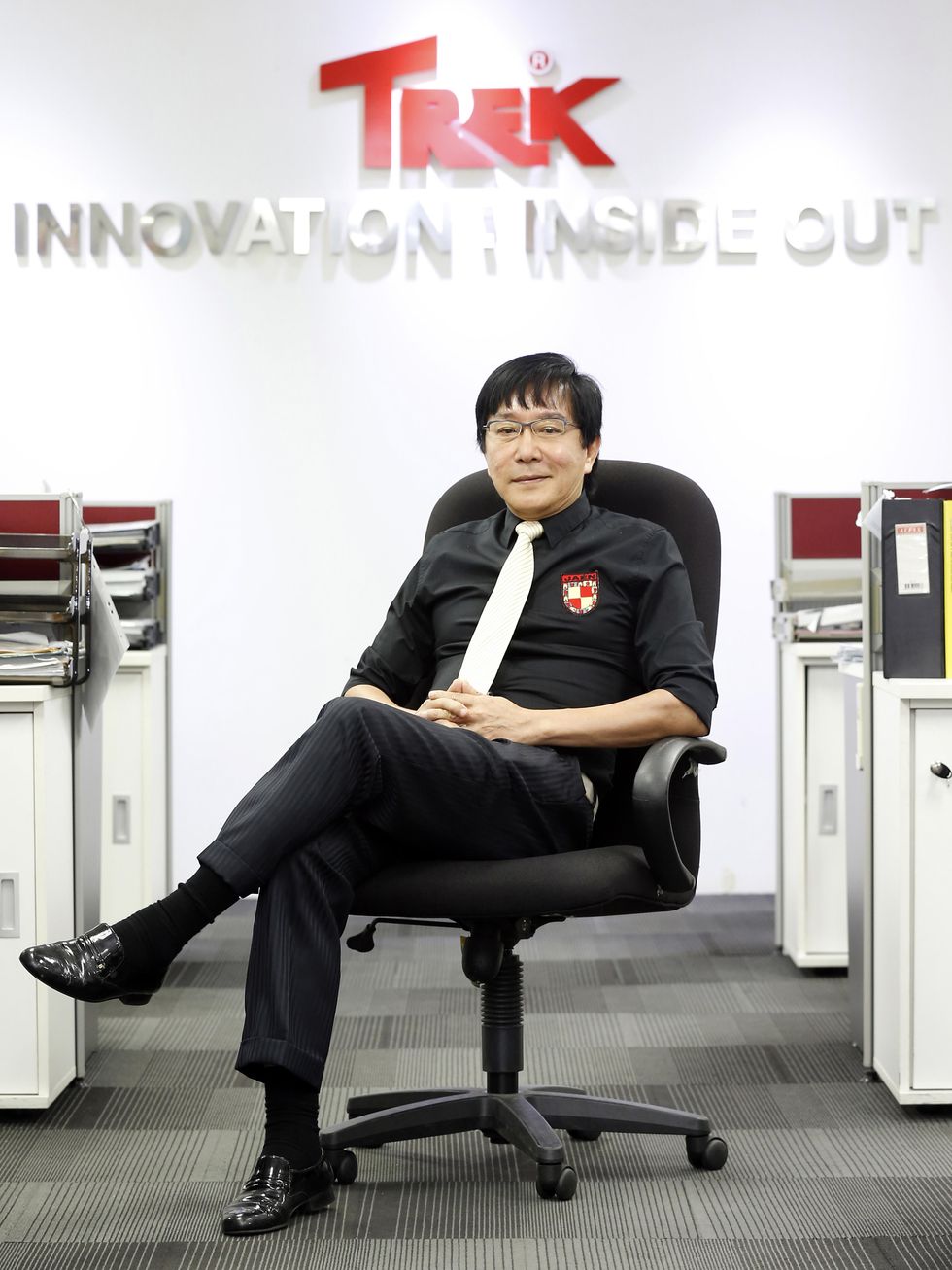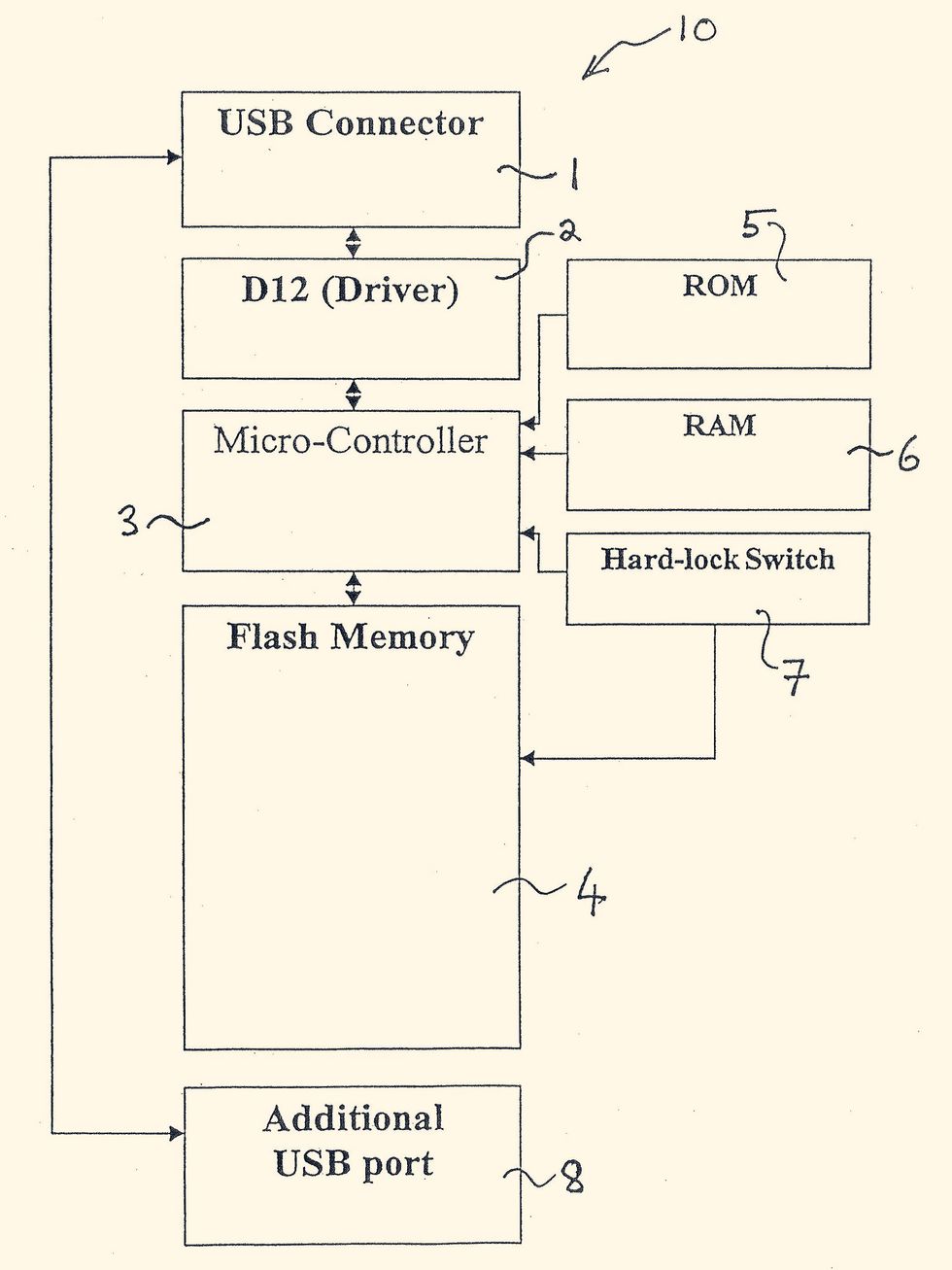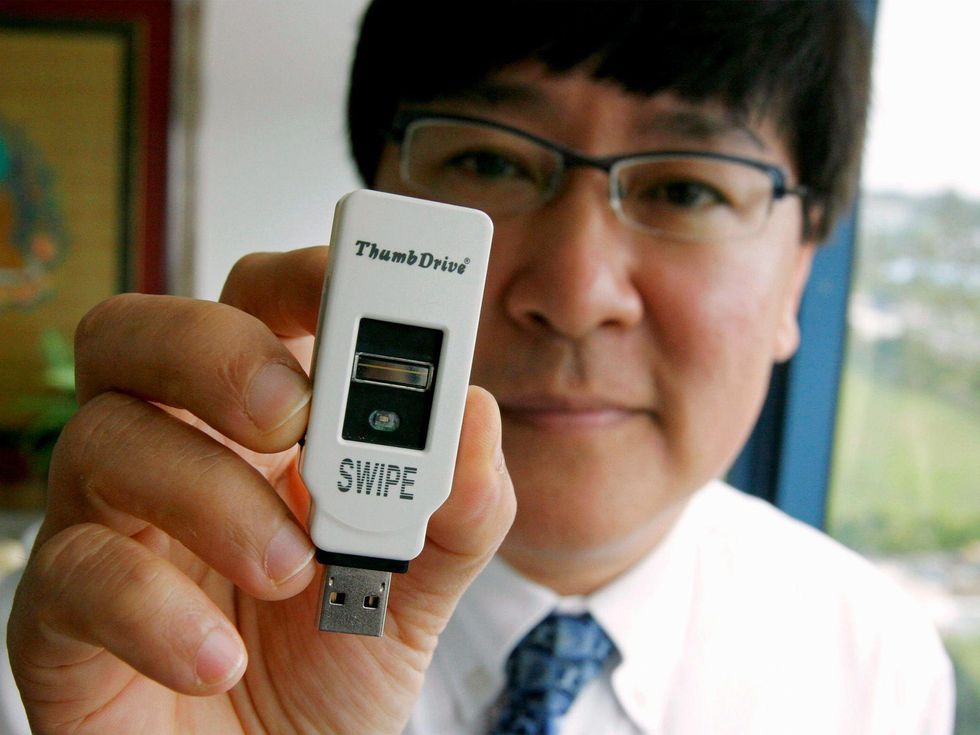The thumb drive was an instant hit, garnering hundreds of orders for samples within hours. Later that year, Trek went public on the Singapore stock exchange, and in four months—from April through July 2000—it manufactured and sold more than 100,000 ThumbDrives under its own label.
Good-bye, floppy disk
Before the invention of the thumb drive, computer users stored and transported their files using floppy disks. Developed by IBM in the 1960s, first 8-inch and later 5¼-inch and 3½-inch floppy disks replaced cassette tapes as the most practical portable storage media. Floppy disks were limited by their relatively small storage capacity—even double-sided, double-density disks could store only 1.44 MB of data.
During the 1990s, as the size of files and software increased, computer companies searched for alternatives. Personal computers in the late 1980s began incorporating CD-ROM drives, but initially these could read only from prerecorded disks and could not store user-generated data. The Iomega Zip Drive, called a “superfloppy” drive and introduced in 1994, could store up to 750 MB of data and was writable, but it never gained widespread popularity, partly due to competition from cheaper and higher-capacity hard drives.
Computer users badly needed a cheap, high-capacity, reliable, portable storage device. The thumb drive was all that—and more. It was small enough to slip in a front pocket or hang from a keychain, and durable enough to be rattled around in a drawer or tote without damage. With all these advantages, it effectively ended the era of the floppy disk.
$7 billion
In 2021, global sales of thumb drives from all manufacturers surpassed $7 billion, a number that is expected to rise to more than $10 billion by 2028.
But Trek 2000 hardly became a household name. And the inventor of the thumb drive and Trek’s CEO, Henn Tan, did not become as famous as other hardware pioneers like Robert Noyce, Douglas Engelbart, or Steve Jobs. Even in his home of Singapore, few people know of Tan or Trek.
Why aren’t they more famous? After all, mainstream companies including IBM, TEAC, Toshiba, and, ultimately, Verbatim licensed Trek’s technology for their own memory stick devices. And a host of other companies just copied Tan without permission or acknowledgment.
Competing claims about the memory stick’s origin
 Maurizio Di Iorio
Maurizio Di Iorio
The story of the thumb drive reveals much about innovation in the silicon age. Seldom can we attribute inventions in digital technology to one individual or company. They stem instead from tightly knit networks of individuals and companies working cooperatively or in competition, with advances made incrementally. And this incremental nature of innovation means that controlling the spread, manufacturing, and further development of new ideas is almost impossible.
So it’s not surprising that overlapping and competing claims surround the origin of the thumb drive.
In April 1999, the Israeli company M-Systems filed a patent application titled “Architecture for a Universal Serial Bus-based PC flash disk.” This was granted to Amir Ban, Dov Moran, and Oron Ogdan in November 2000. In 2000, IBM began selling M-Systems’ 8-MB storage devices in the United States under the less-than-memorable name DiskOnKey. IBM has its own claim to the invention of an aspect of the device, based on a year-2000 confidential internal report written by one of its employees, Shimon Shmueli. Somewhat less credibly, inventors in Malaysia and China have also claimed to be the first to come up with the thumb drive.
The necessary elements were certainly ripe for picking in the late 1990s. Flash memory became cheap and robust enough for consumer use by 1995. The circulation of data via the World Wide Web, including software and music, was exploding, increasing a demand for portable data storage.
When technology pushes and consumers pull, an invention can seem, in retrospect, almost inevitable. And all of the purported inventors could certainly have come up with the same essential device independently. But none of the many independent stories of invention paint quite as clear an origin story—or had as much influence on the spread of the thumb drive—as the tale of Tan in Singapore.
Henn Tan: From truant to entrepreneur
 Henn Tan, shown here in 2017, fought a series of mostly losing battles against those who pirated Trek 2000’s ThumbDrive design and against rival patent claims. Yen Meng Jiin/Singapore Press/AP
Henn Tan, shown here in 2017, fought a series of mostly losing battles against those who pirated Trek 2000’s ThumbDrive design and against rival patent claims. Yen Meng Jiin/Singapore Press/AP
Tan, the third of six brothers, was born and raised in a kampung (village) in the neighborhood of Geylang, Singapore. His parents, working hard to make ends meet, regularly left Tan and his brothers alone to roam the streets.
The first in his family to attend high school, Tan quickly fell in with a rebellious crowd, skipping school to hang out at roadside “sarabat” (drink) stalls, dressed in “shaggy embroidered jeans, imbibing coffee and cigarettes, and tossing his long mane as he polemicized about rock music and human rights,” according to a 2001 article in the Straits Times. After a caning for truancy in his third year of high school that served as a wake-up call, Tan settled down to his studies and completed his O-level exams. He entered the National Service in 1973 as a military police instructor, and after serving the required two years, he took a job as a machinist at a German multinational firm.
This wasn’t a rare job at the time. In the late 1960s Singapore had embarked on a crash program of industrialization, offering incentives to multinational companies, especially in such high-tech fields as electronics and semiconductors, to set up factories on the island. By the early 1970s, Singapore was home to manufacturing plants for Fairchild Semiconductor, General Electric, Hewlett Packard, and Texas Instruments, among others. These companies were joined by the Japanese firms Matsushita (now Panasonic) in 1973 and Nippon Electric Company (now NEC) in 1977.
Tan diligently saved money to pay for driving lessons. As soon as he had his license, NEC’s semiconductors division hired him as a sales executive. Three years later, in 1980, he moved to Sanyo as a regional sales manager. Over the next 15 years, he rose to the rank of sales director, accumulating a wealth of experience in the electronics industry, including connections to a range of suppliers and customers.
The Asian electronics industry takes off
In 1995, Tan resigned from Sanyo and purchased Trek, a small, family-run electronics component trading firm in his old neighborhood of Geylang, for just shy of US $1 million. He planned to develop products to license or sell to one or more of the many large multinationals in Singapore.
Meanwhile, worldwide sales of computer equipment had started to boom. Although personal computers and various portable computers had been around since the late 1970s, both Apple and IBM released flagship laptops in 1991 and 1992, respectively. Along with the popularity of laptops came a growing demand for peripherals such as displays, modems, printers, keyboards, mice, graphics adapters, hard drives, CD-ROM drives, and floppy drives. The dot-com boom of 1995 to 2000 further increased demand for personal computing gear.
“Clones, in a sense, are marvelous….it meant you must have a good idea and you should make the most of it, as quickly as possible.”—Henn Tan, as told to the Straits Times
Many of these electronics products, including the chips in them, were produced in Asia, including Hong Kong, Indonesia, Malaysia, South Korea, Taiwan, Thailand—and Singapore—under the OEM system. These “original equipment manufacturers” made computers for Apple, Dell, and other companies who outsourced the production of their designs.
By the mid-1990s, Singapore had become an important hub for electronics manufacturing, including hard drives and semiconductor wafers, and the island had a significant and growing electronics ecosystem with design and production expertise.
Toshiba gives Tan his big break
All this activity, however, did not create an easy path for Tan. Many of his old contacts from Sanyo wouldn’t do business with a no-name like Trek. And few talented engineers wanted to work for a company that seemed to offer little guarantee of long-term employment. But Tan persisted, and after two years, in 1998, he got his big break: Toshiba Electronics in Singapore appointed Trek as an official design house, an agreement through which Trek would design and manufacture products to be sold under the Toshiba label.
In particular, Toshiba wanted an MP3 player, a compact and portable solid-state device that could copy music files from a computer, to which it would be connected via a USB plug, and then play the music back. Though this was before Apple’s 2001 iPod made these devices popular worldwide, a number of MP3 players of varied quality were already on the market in the late 1990s.
As the originator of flash memory, Toshiba manufactured storage chips used in personal computers, laptops, and digital cameras. Toshiba also made portable radios and boom boxes. It wasn’t odd that the company wanted to jump into the MP3-player fray.
But Tan reasoned that “if the company just manufactured the player, it would not make a lot of money,” according to a 2005 article in the Straits Times. Tan thought that by leaving out the ability to play music, the device would become more versatile, able to handle not just MP3s but also text, spreadsheets, images—any kind of computer file. Many companies were already selling music players, but a cheap, USB-driven, versatile storage device might have an even bigger market, Tan suspected, and he could be first to tap it.
Tan did give Toshiba its music player. But he also set his engineers to work on a product that was essentially a music player without the player. The result was the thumb drive.
From popular product to pirate battle
 Trek’s patent application for the ThumbDrive included this drawing.
Trek’s patent application for the ThumbDrive included this drawing.
Getting to a working product was not trivial—the drive required not only the appropriate combination of hardware but also specially designed firmware that allowed the solid-state storage to interact with a variety of computer operating systems.
But the thumb drive, with its flash memory and USB interface, was hardly a completely novel invention. Tan did not invent flash memory, which was the brainchild of Toshiba engineer Fujio Masuoka in 1980. Nor did he invent the USB port, which had been around since 1996. What was novel was the combination of the USB with flash memory plus a controller and appropriate firmware, all sealed into a plastic case to make a marketable consumer product.
Local circumstances can partly explain why the thumb drive came to be invented where and when it did: Tan’s experience at NEC and Sanyo, Trek’s contract with Toshiba, and the connections Trek’s engineers had made during previous internships at other companies in Singapore were all important. Those same factors, however, also made the invention difficult to control. Once the idea of the thumb drive was out there, many electronics firms immediately set to making their own versions. Tan had filed a patent application for his invention in 2000, a month before the German tech fair where Trek introduced the device, but a pending patent did little to stop copycats.
In addition to claims by M-Systems and IBM, perhaps the most complicated rivalry came from the Chinese company Netac Technology. It also claimed to have invented the flash memory stick. Cheng Xiaohua and Deng Guoshun had previously worked for Trek and had seen some development boards related to flash memory. They returned to Shenzhen, China, and founded Netac in 1999.
Shenzhen at the time was a hotbed of electronics copycatting—DVD players, cellular phones, MP3 players, and numerous other consumer electronics were produced as “shanzhai” goods, outside the bounds of intellectual property laws. Netac’s claim to (and production of) its thumb drive fit this pattern of appropriation.
Netac and Trek subsequently even entered into an agreement under which Trek would fund some of Netac’s research and development and Trek would gain rights to manufacture and distribute the resulting products outside of China. Despite this collaboration, Netac sought and was granted a patent on the thumb drive within China.
Henn Tan thought that by leaving out the ability to play music, the device would become more versatile.
Electronics pirates around the world then went after the thumb drive. Tan fought them hard and sometimes won. Had Trek been a larger company with more resources and more patent experience, the story might have had a different ending. As it was, though, Trek’s patents stood on relatively weak ground. Beginning in 2002, Tan brought suit in Singapore against a handful of companies (including Electec, FE Global Electronics, M-Systems, and Ritronics Components) for patent infringement. After several years of court battles and hundreds of thousands of dollars in legal fees, Trek won that case, persuading the judge that its ThumbDrive was the first device ever designed to be plugged directly into a computer without the need for a cable. An appeals court in the United Kingdom, however, was not persuaded, and Trek lost its patent there in 2008. Tan also pursued, with little success, claims at the United States International Trade Commission against other companies, including Imation, IronKey, Patriot, and Verbatim. But even the decision in Singapore was little more than a moral victory. By the late 2000s, millions of thumb drives had already been produced, by countless companies, without Trek’s license.
“Clones,” Tan told the Straits Times in 2005, “in a sense, are marvelous. In the business world, especially when you are in Asia, as long as anything makes a profit, you do it.” If someone were copying you, Tan reasoned, “it meant you must have a good idea and you should make the most of it, as quickly as possible.”
Ultimately, Tan and Trek turned their attention to new products, each improving slightly on the last. By 2010, Trek had developed another pioneering device—the Flu Drive or Flu Card. This modified thumb drive could also wirelessly transmit data between devices or to the cloud. Although Tan still attempted to protect his invention with patents, he had also embraced a new path: success through continuous novelty.
The Flu Card enjoyed modest success. Although not widely taken up as a stand-alone device, its Wi-Fi connectivity made it suitable for consumer electronics devices such as cameras and toys. In 2014, Trek signed deals with Ricoh and Mattel China to license the Flu Card design.
Trek also attempted to move into new markets, with limited success, including the Internet of Things, cloud technology, and medical and wearable devices.
Trek’s struggles and Tan’s fall
 Henn Tan holds up a ThumbDrive during an interview in Singapore in January 2006.Nicky Loh/Reuters/Alamy
Henn Tan holds up a ThumbDrive during an interview in Singapore in January 2006.Nicky Loh/Reuters/Alamy
Trek’s revenue from licensing the ThumbDrive and the Flu Card was not sufficient to keep it profitable. But instead of admitting how badly the company was doing, in 2006, Tan and his chief financial officer began falsifying Trek’s accounts, deceiving auditors and shareholders. After these misdeeds were revealed by financial auditors Ernst & Young in 2015, Tan stepped down as chairman and chief executive and in August 2022 pled guilty to falsifying accounts. As of this writing, Tan remains in jail in Singapore. His son, Wayne Tan, continues as Trek’s deputy chairman.
Meanwhile, the thumb drive lives on. Although most of us transmit our files over the Internet—either as email attachments or through services like Google Drive and Dropbox—thumb drives (now running to capacities measured in terabytes) remain a convenient device for carrying data in our pockets.
They are used as a quick way to transfer a file from one computer to another, pass out press kits at conferences, lock and unlock computers, carry apps to run on a shared computer, back up travel documents, and even, sometimes, store music. They are used for nefarious purposes as well—stealing files or inserting malware into target computers. And they are especially useful for the secure transfer of encrypted data too sensitive to send over the Internet.
In 2021, global sales of the devices from all manufacturers surpassed $7 billion, a number that is expected to rise to more than $10 billion by 2028, according to Vantage Market Research.
Hero or antihero?
Often, we think of inventors as heroes, boldly going where no one has gone before. But Tan’s story isn’t that simple.
Tan does deserve a place in consumer electronics history—he conceived the device without seeing one first, made it work, manufactured it in quantities, and spread it broadly, both intentionally through licensing and unintentionally through copying. But full credit for the thumb drive really belongs more to the environment—the ideas circulating at the time and the networks of clients and suppliers—than any individual.
Moreover, the conclusion of Tan’s story suggests he is more antihero than hero. We usually admire inventors for their tenacity and grit. In Tan’s case, these qualities contributed to his downfall. Determined to take moral and financial credit for the thumb drive, Tan went to extraordinary lengths—even breaking the law—in order to make his company and himself a success. The thumb drive shows how complicated stories of invention often are.
This article appears in the February 2023 print issue.
From Your Site Articles
Related Articles Around the Web
#Lisa #Apples #Failure






